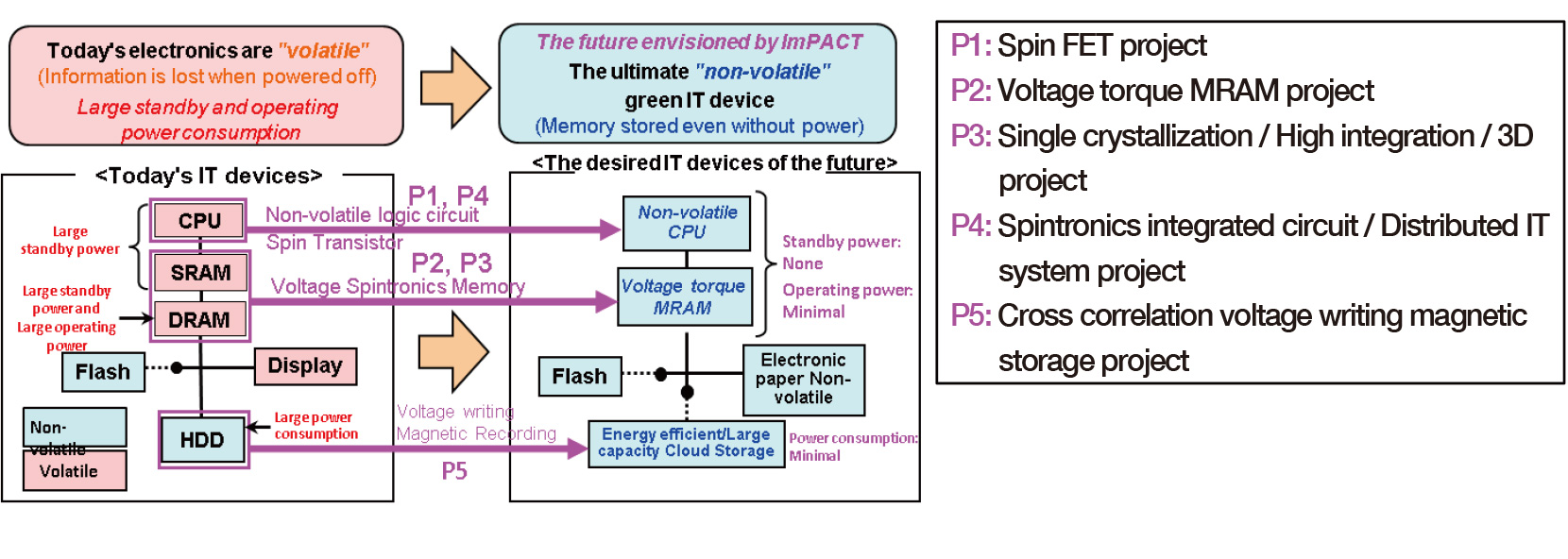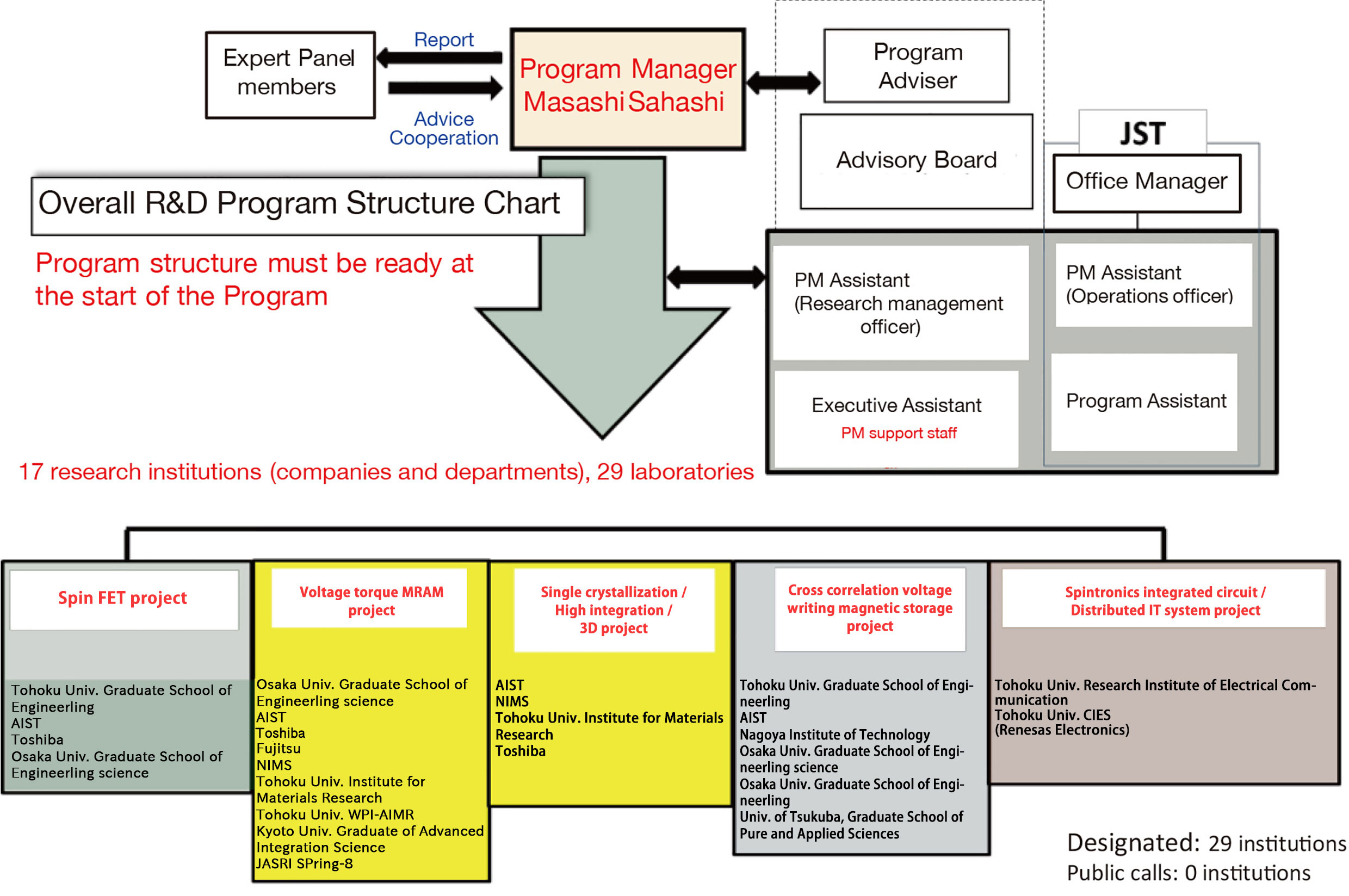
Achieving Ultimate Green IT Devices with Long Usage Time without Charging
Program Manager
Masashi Sahashi
Masashi Sahashi
1974 Graduate, Nagoya University Master's Course
1974 Researcher, Toshiba Research& Development Center
1999 Senior Fellow , Toshiba Research& Development Center
2002 Doctorate, Engineering (Nagoya University Graduate School)
2003 Professor, Tohoku University Graduate School of Engineering
2014- ImPACT Program Manager
(Joint appointment between Tohoku Univ. and JST; Eeffort: 80%)
1974 Researcher, Toshiba Research& Development Center
1999 Senior Fellow , Toshiba Research& Development Center
2002 Doctorate, Engineering (Nagoya University Graduate School)
2003 Professor, Tohoku University Graduate School of Engineering
2014- ImPACT Program Manager
(Joint appointment between Tohoku Univ. and JST; Eeffort: 80%)
Profile
As a Corporate Project Manager at Toshiba, Sahashi developed the world's first HDD with a GMR head and guided its commercialization, which garnered him the Nikkei BP Technology, Grand Awards, the Onshi Invention Award, and the Shijuhosho (Medal of Honor with Purple Ribbon). After his university career, he has been promoting high‐risk revolutionary basic research and transplanting the seeds of new businesses at companies.
As a Corporate Project Manager at Toshiba, Sahashi developed the world's first HDD with a GMR head and guided its commercialization, which garnered him the Nikkei BP Technology, Grand Awards, the Onshi Invention Award, and the Shijuhosho (Medal of Honor with Purple Ribbon). After his university career, he has been promoting high‐risk revolutionary basic research and transplanting the seeds of new businesses at companies.
What's New
2019/2/19[Press Release]
Development of nonvolatile spintronics-based 50μW microcontroller unit operating at 200MHz 
2018/12/11[Press Release]
Magnetic tunnel junctions with a nearly zero moment manganese nanolayer with perpendicular magnetic anisotropy 
2018/2/20[Press Release]
Unprecedented single-digit-nanometer magnetic tunnel junction demonstrated 
2017/7/26[News]
The 3rd ImPACT International Symposium on Spintronic Memory,Circuit and Storage
Overview
Information and communication technologies have greatly changed our daily life-style through the widespread use of mobile devices and cloud computing. But conventional mobile devices must be recharged frequently, and the number of rechargers that must be left plugged into power outlets continues to increase, which results in the increase in wasting energy. Finding ways to decrease energy consumption which is increasing further with the use of “big data” and the Internet of Things (IoT), is a serious issue that our society faces. This program will resolve this societal issue through technologies such as the ultimate in non-volatile memory that uses voltage to record data to magnetic memory, and spintronics logic integrated circuits that consume little power, in order to achieve ultimate power savings at each computer memory and storage level. This will reduce the power consumption of IT devices down to the possible lowest level and creates a pleasant and environment-friendly IT society free from the stress of recharging, as well as a safe and secure society that enables access to information even in the event of a major disaster. 

Disruptive Innovation
Keys to breakthrough
- Today's mainstream large-capacity memory DRAMs and non-volatile memory MRAMs that are in development require large currents for writing information, which limits their energy efficiency.
- Developed the Voltage Torque MRAM, a new type of high-speed and energy-efficient memory that can write information with voltage and store the information for long periods.
- With zero standby power consumption and operating power consumption that is 1/100th of existing memory, the ultimate in green IT has been achieved.

The Challenges for the PM and the Impact of Success
Overview and background
- Today's mobile IT devices require frequent charging.
- The number of charger devices that are left plugged in at the home and office is exploding.
- Risk of loss of access to emergency information during a large-scale disaster or prolonged power outage.
Impact on industry and society in the event of achievement
- Dramatically reduce IT device power consumption by using magnetic memory transistors that use voltage to record information and that can store the information for long periods to enable a comfortable lifestyle free of recharge anxiety.
- Realize a safe and secure IT society where information is accessible during largescale disasters and prolonged power outages through a distributed spintronics IT system that is powered by harvested energy.

Scenario for Success and Achievement Targets
Methods of resolution for success (Approach)
- Achieve voltage control of magnetic storage layers utilizing leading‐edge spintronics thin film technology , physics and fabrication technology for elements.
- Comprehensively engage in the implementation of non‐volatile functions in all layers of use, including cloud and mobile storage, memory and cache, and math processing, and engage in the development of ultra‐low power and current writing technology (merging of magnetism and semiconductors).
- Real progress has been made in the last several years in basic research on voltage spintronics, which has now undercut 1 femtocoulomb of electric charge to write 1 bit of information.
Management strategies
- Clarify the aim of each project and the commercialization target. For the development of common fundamental technologies, accelerate the pace of development by implementing principles of cooperation and competition, and introduce new methods by calling for participants.
Achievement targets
- Create a pioneering and overwhelming differentiating technology in the memory and PC business markets, overtake the market, and gain an outlook on achieving ultimate green IT devices. ∙ Attain low power consumption that is a magnitude less than compared with DRAMs and STT‐MRAMs, and break through the scaling limit (10 nm generation cache/memory (MRAM)).
- Develop an ultra‐high energy efficient microcomputer.
Risks
- Achieving magnetic control through voltage will require elucidation of the physics involved, such as of voltage effects on interface.
- Management to run multiple large projects simultaneously.
Overall R&D Program Structure Created by the PM

Implementation Structure as Assembled by the PM
Keys of the implementation structure
- Placed projects to cover each layer of IT including math processing (spin transistors, integrated logic circuits), cache and main memory, and cloud storage and appointed PLs who have a track record in leading research and were central to the research achievements. Laid out a formation of personnel capable of achieving overwhelming differentiation for the program in a globally and competitively cutthroat field.
- Established an advisory board comprising multiple experts. Provided a stage for all projects by establishing an intellectual property capability meeting and making technical competitiveness a criteria.
Approach to selection of institutions
- This program, which requires large facilities, has a hub type structure based on the premise of common utilization of existing facilities along with newly installed facilities, with direct invitations to the institutions that have researchers who have made outstanding breakthroughs. The institutions are also capable of competitively and aggressively participating as a satellite for each project. Tohoku University, Toshiba, and AIST are organizations with affiliated researchers who are central to their globally leading research and are indispensable as satellite institutions.

Organization
The Cabinet Office
ImPACT: Impulsing Paradigm Change through Disruptive Technologies Program
ImPACT Program Manager
Masashi Sahashi
ImPACT: Impulsing Paradigm Change through Disruptive Technologies Program
ImPACT Program Manager
Masashi Sahashi
Associate Program Manager
Eiichi Suzuki
Eiichi Suzuki
Associate Program Manager
Yoshikazu Miyashita
Yoshikazu Miyashita
Associate Program Manager
Youhei Shiokawa
Youhei Shiokawa

